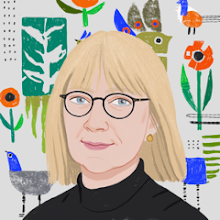
Each city in Japan has manhole covers specifically designed for the locale. This one is from Tokyo.
Editor's Comments
SchoolArts Magazine, October 2008
http://www.davis-art.com/Portal/SchoolArts/SAdefault.aspx
Though my first degree is in graphic design, I received it so long ago that we used press-on type and handlettering in school. As I recall, we mostly designed print materials and advertisements.
Fortunately, design has changed quite a bit since then and we have two distinguished guest editors this month who have happily shared their expertise and experience with contemporary design education. They are Martin Rayala, assistant professor of Art and Design Education at Kutztown University of Pennsylvania and Paul Sproll, head of the Department of Teaching + Learning in Art + Design at the Rhode Island School of Design.
Our focus this month is not on design in terms of the elements and principles of design, but on the design of objects, images, places, and experiences. Designers have the unique ability to make us want things we didn’t even know we wanted or needed. Retail businesses such as Target and IKEA have built their reputations and success on the basis of selling good design. Web design has become a major factor in the success of websites.
As I write this, I am riding on the shinkansen, Japan’s bullet train, in a country strongly influencing design today, especially in the areas of electronics, anime, and manga, as well as product, automotive, and industrial design. The train is low, sleek, and smooth riding; it certainly doesn’t feel like we are going 200 miles per hour.
I am in Japan as a fortunate participant in the Japan Fulbright Memorial Fund Teacher Program, spending three weeks visiting schools of all levels and learning about Japanese education, culture, and art. In Origins: The Creative Spark behind Japan’s Best Product Designs, author Shu Hagiwara sets forth Japan’s enduring trends in design to be “outward simplicity, miniaturization, portability, warmth of texture, and playfulness.” I have certainly found that to be true. Even the manhole covers are different for each city, with designs that highlight characteristics of the locale.
Japan, like the United States, is a consumer society. Our similarities in this area are obvious when considered through the lens of Ernest Boyer’s human commonalities, cultural similarities shared by all peoples, especially of his delineation of “We all produce and consume.”
Good design and good designers can help invest work with meaning and create more critical consumers. Design thinking can help students become successful adults with the twenty-first-century skills of creativity and innovation, critical thinking and problem solving, and communication and collaboration.
We hope this issue will inspire design thinking in you and your students, and that you will share the results of your efforts with SchoolArts.




































